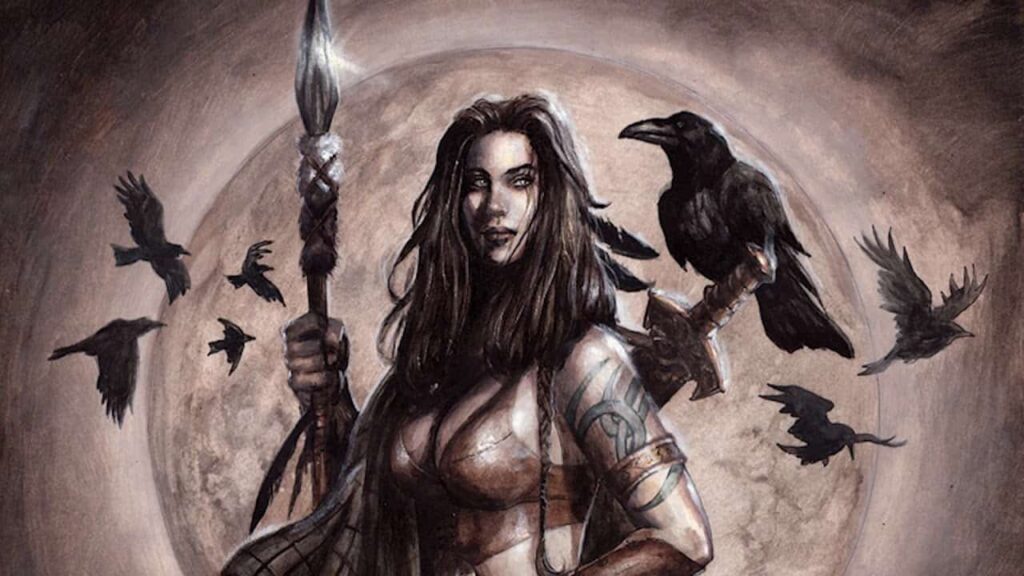Irish mythology, captivating tales, ancient folklore
Once upon a time, in the lush green landscapes of Ireland, where the mists danced upon the hills and the rivers whispered secrets, there existed a world teeming with enchantment and wonder. It was a realm where myth and reality intertwined, where gods and goddesses, heroes, and heroines, walked amongst ordinary folk, and where legends were born.
As I sit by the hearth, the warmth of the fire caressing my face, I feel compelled to share with you the tales that have been passed down through generations. These are the stories of Irish mythology, the ancient folklore that has captured the hearts and minds of people for centuries.
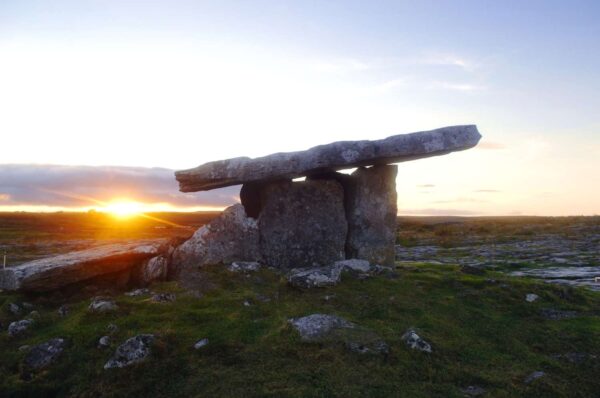
In the realm of Irish mythology, the Tuatha Dé Danann reigned supreme. They were a divine race, believed to be the children of the goddess Danu. Their world was one of beauty and magic, where music flowed like the rivers and the land itself breathed with life. I was told that they possessed extraordinary powers, able to shape-shift and command the elements at will.
I recall the tales passed down through generations. It is said that the Tuatha Dé Danann were the descendants of the goddess Danu, who imbued them with otherworldly powers and wisdom. They were beings of great beauty and grace, with the ability to shape-shift and command the elements.
The Tuatha Dé Danann’s world was a realm of abundance and enchantment. Their majestic cities, hidden from mortal eyes, shimmered with ethereal light. I was told that the city of Tara, their capital, was a place of splendour, where music and poetry filled the air, and the arts flourished. It was a realm where time seemed to stand still, and the beauty of the natural world was celebrated and revered.
These divine beings possessed a deep connection to the land and its creatures. They could commune with animals, plants, and the spirits that dwelled in every corner of the Irish landscape. I heard stories of how they could speak to the trees, who whispered ancient secrets and wisdom to them. They understood the ebb and flow of nature, the dance of the seasons, and the delicate balance of life.
But the Tuatha Dé Danann were not just peaceful beings of beauty they were also formidable warriors when needed. They possessed weapons of great power, forged by skilled craftsmen. The spear of Lugh, the sword of Nuada, and the cauldron of the Dagda were among their most revered artifacts, each with its own legendary abilities.
Their encounters with mortals were both fateful and transformative. When the Milesians, a mortal race, arrived in Ireland seeking to claim the land as their own, the Tuatha Dé Danann engaged in battles to defend their homeland. The famous Battle of Mag Tuired was fought, where the Tuatha Dé Danann showcased their martial prowess and magical abilities. Though they ultimately lost the battle, they managed to negotiate a peace treaty that allowed them to retreat to the mystical realms of fairy mounds, where they continued to influence the course of Irish history.
The Battle of Mag Tuired, one of the most pivotal events in Irish mythology, was a clash of epic proportions between the Tuatha Dé Danann and the invading Milesians. It was a battle that would shape the course of Irish history and mark a transition from the divine reign of the Tuatha Dé Danann to the mortal era.
The conflict arose when the Milesians, led by their leader, Amergin, set their sights on conquering Ireland. They believed that the island was rightfully theirs, and they were determined to claim it. The Tuatha Dé Danann, the divine race who had long ruled over Ireland, stood in their way, unwilling to relinquish their sacred land.
The battle took place at the plain of Mag Tuired, a sacred site imbued with mystical power. The armies assembled, each side brimming with skilled warriors and powerful magic. The Tuatha Dé Danann, renowned for their sorcery and combat prowess, were determined to defend their homeland and maintain their dominion.
The battle raged with a ferocity that shook the very earth beneath their feet. The sky crackled with lightning, and the clash of weapons echoed across the plains. The Tuatha Dé Danann employed their magical arts, unleashing storms, summoning mystical creatures, and wielding their legendary weapons with skill and precision.
At the forefront of the Tuatha Dé Danann’s defence was their king, Nuada, a formidable warrior known for his skill with the sword. But it was the great warrior Lugh, the master of many arts, who turned the tide of the battle. Lugh’s spear, a weapon of unparalleled power, struck fear into the hearts of the Milesians as he led his comrades with unmatched bravery and strategic brilliance.
Yet, despite their valour, the Tuatha Dé Danann could not withstand the sheer numbers and relentless assault of the Milesians. In the end, they were forced to retreat. However, the battle was not without its consequences for both sides. Many lives were lost, and the landscape was forever marked by the echoes of their struggle.
Yet, the Tuatha Dé Danann, with their deep connection to the land and the supernatural, were not easily defeated. They negotiated a peace treaty with the Milesians, securing their right to retreat into the mystical realms of fairy mounds and underground chambers. There, they would continue to exert their influence over Irish history, guiding and shaping the destiny of the land they loved.
The Battle of Mag Tuired stands as a testament to the courage and resilience of the Tuatha Dé Danann. It is a reminder of their formidable powers and the indelible mark they left on Irish mythology. Their legacy lives on in the ancient stories and traditions of Ireland, reminding us of the profound connection between myth and history, and the enduring power of the human spirit.
The legacy of the Tuatha Dé Danann lives on in the folklore and traditions of Ireland. Their stories have inspired countless artists, poets, and storytellers, who have kept their memory alive through the ages. Even today, their presence can be felt in the hidden realms of the Irish landscape, where ancient monuments and fairy forts stand as reminders of their once-mighty presence.
So, dear friends, let us immerse ourselves in the enchanting realm of the Tuatha Dé Danann, where the veil between the mortal world and the supernatural is thin. Let us honour their wisdom, their artistry, and their deep connection to the land. For within their stories lies a profound understanding of the delicate balance between the seen and unseen, the tangible and the mystical, and the timeless mysteries that continue to shape the soul of Ireland.
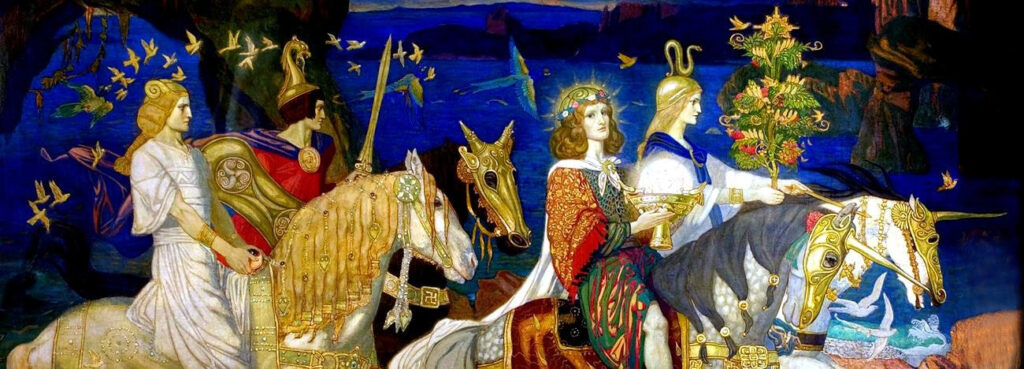
Another of the most renowned heroes of Irish mythology was of the most renowned heroes of Irish mythology was Cú Chulainn, a mighty warrior known for his bravery and ferocity in battle. Born of divine lineage, his deeds were sung in epic poems and celebrated throughout the land.
I heard tales of his legendary feats, from his battle against the fearsome hound of Culann to his valiant defence of Ulster against Queen Medb’s army., a mighty warrior known for his bravery and ferocity in battle. Born of divine lineage, his deeds were sung in epic poems and celebrated throughout the land. I heard tales of his legendary feats, from his battle against the fearsome hound of Culann to his valiant defence of Ulster against Queen Medb’s army.
Cú Chulainn, the legendary hero of Irish mythology, is a figure whose name resounds with tales of bravery, strength, and indomitable spirit. Let us embark on a journey into the captivating world of this iconic hero, a man whose deeds and adventures have become the stuff of legend.
Born Setanta, he earned his renowned name, Cú Chulainn, meaning “Culann’s Hound,” after an incident that would come to define his character. As a young boy, Setanta was invited to a feast at the house of Culann, a prominent smith. On his way, he encountered a fierce hound guarding the entrance. Undeterred, Setanta defeated the hound in a display of remarkable strength and agility.
Impressed by the boy’s courage, Culann invited him into his home, where he bestowed upon him the new name, Cú Chulainn, signifying his incredible prowess and his unwavering loyalty. From that moment forward, Cú Chulainn’s destiny was intertwined with the fates of kings, warriors, and the land of Ireland itself.
Cú Chulainn’s legend grew as he undertook numerous heroic feats, protecting the land and its people from threats both mundane and supernatural. His most renowned tale, the Táin Bó Cúailnge or “Cattle Raid of Cooley,” showcased his unmatched prowess and unyielding determination.
The Cattle Raid of Cooley, also known as Táin Bó Cúailnge, is a legendary tale that epitomizes the heroic feats and epic battles of Irish mythology. Let us delve into the enthralling story of this ancient saga, filled with valour, honour, and the pursuit of mythical treasures.
The tale unfolds in a time when the mighty Queen Medb of Connacht sought to acquire the revered Brown Bull of Cooley, a magnificent and prized creature said to possess unmatched strength and beauty. In her relentless quest for power and riches, Queen Medb assembled a vast army to invade the kingdom of Ulster, home to the prized bull.
Standing in her way was the young hero Cú Chulainn, a warrior of unparalleled skill and courage. Despite his youth, Cú Chulainn possessed a warrior spirit forged by countless battles and trials. Aware of the impending conflict, he took it upon himself to defend his homeland against Queen Medb’s forces.
As Queen Medb’s army marched into Ulster, Cú Chulainn singlehandedly challenged them, engaging in a series of legendary battles that would become the stuff of legends. One by one, he faced and defeated the mightiest warriors of Connacht, displaying his incredible strength, agility, and cunning tactics.
Cú Chulainn’s most famous encounter during the Cattle Raid of Cooley was his duel against the fearsome warrior Ferdiad, his childhood friend and fellow warrior. Their clash was a heart-wrenching display of skill and emotional turmoil, as the two friends were forced to fight each other in a battle that would determine the fate of the Brown Bull.
The epic showdown between Cú Chulainn and Ferdiad is a symbol of conflicting loyalties, honour, and the tragedy of war. Both warriors fought with unmatched ferocity and determination, each displaying their individual strengths and weaknesses. Ultimately, Cú Chulainn emerged victorious, but at a great cost—the loss of his dear friend and the weight of the toll such battles take on the human soul.
Throughout the Cattle Raid of Cooley, Cú Chulainn faced numerous challenges and trials, from battling formidable foes to enduring gruelling hardships. His unwavering loyalty to his people and his commitment to defending the land of Ulster became legendary, earning him a place in the pantheon of Ireland’s greatest heroes.
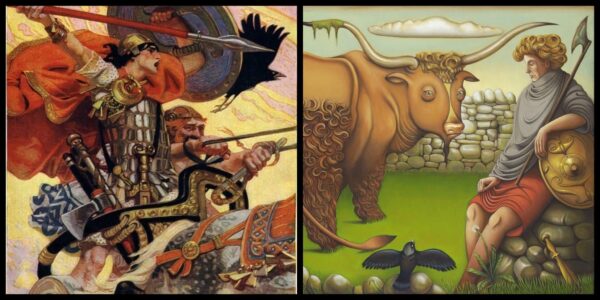
The tale of the Cattle Raid of Cooley is more than just a story of battles and conquest. It delves into themes of honour, sacrifice, and the complexities of human nature. It showcases the unwavering spirit of the Irish people and their deep connection to the land and its treasures.
As we listen to the echoes of this ancient saga, we are reminded of the timeless lessons it imparts. It speaks of the consequences of greed, the price of heroism, and the transformative power of selfless acts. The Cattle Raid of Cooley is a testament to the enduring power of myth, captivating hearts, and minds across generations, and reminding us of the profound wisdom and universal truths contained within the ancient tales of Ireland.
During the Táin Bó Cúailnge, Cú Chulainn singlehandedly defended Ulster against the forces of Queen Medb of Connacht. His remarkable combat skills were often enhanced by his ríastrad, a battle frenzy that bestowed upon him otherworldly strength and ferocity. In this state, his appearance would change, and his enemies would tremble at the sight of his contorted face and bulging veins.
With his trusted charioteer, Láeg, by his side, Cú Chulainn engaged in legendary duels and encounters, striking fear into the hearts of his foes. He faced powerful adversaries, such as the warrior queen Scáthach, who trained him in the arts of combat, and the Morrígan, the shape-shifting goddess of war and fate.
But Cú Chulainn’s story was not just one of battles and martial prowess. He possessed a complex and deeply human nature, with flaws and vulnerabilities that mirrored his immense strength. His loyalty to his land and people sometimes led him down a path of tragedy and sorrow.
One of the most poignant moments in Cú Chulainn’s tale is his tragic death. In a battle against Lugaid, the son of Cú Roí, Cú Chulainn fought valiantly but was ultimately struck down. Even in death, he displayed his unwavering courage, tying himself to a stone pillar to face his enemies in a defiant final stand.
The legacy of Cú Chulainn endures, his tales passed down through generations, inspiring courage, and resilience in the face of adversity. His story speaks of the power of heroism, the complexities of human nature, and the enduring spirit of the Irish people.
As we reflect upon the mythic figure of Cú Chulainn, let us remember his indomitable spirit, his unwavering loyalty, and his ceaseless dedication to protecting the land he loved. His legend stands as a testament to the power of myth and the enduring impact of heroic tales in shaping our collective imagination.
But it wasn’t just heroes who held a place in Irish mythology; there were also captivating creatures that inhabited the land. The sidhe, or faeries, were said to dwell in hidden mounds and enchanted forests. Their ethereal beauty and mischievous nature captivated the imagination, and I know that many travellers ventured into the wilderness in search of their elusive presence.
The saga is steeped in rich symbolism and layered narratives, reflecting the complex interplay between human desires, political ambitions, and the forces of destiny. At its core, the Cattle Raid of Cooley explores themes of honor, bravery, and the sacrifices made in the pursuit of power and glory.
Queen Medb of Connacht, driven by her insatiable ambition, sought to rival the wealth and prestige of her husband, King Ailill. To achieve this, she set her sights on acquiring the Brown Bull, a creature of legendary stature said to possess unmatched strength and beauty. Medb’s determination to obtain the bull became a symbol of her desire for dominance and her relentless pursuit of greatness.
The saga unfolds with intricate detail, painting vivid portraits of the characters involved and the challenges they face. Cú Chulainn, the central hero of the story, emerges as a figure of unmatched skill and bravery. Despite his youth, he possesses extraordinary abilities and a fierce determination to defend his homeland.
Cú Chulainn’s solitary stand against the forces of Connacht serves as a testament to his unwavering loyalty to Ulster and his unyielding commitment to honor. He engages in a series of epic battles, facing formidable foes and overcoming insurmountable odds. His heroic deeds in the face of overwhelming opposition have become legendary, solidifying his place as one of Ireland’s greatest heroes.
The Cattle Raid of Cooley is not simply a tale of physical conflict and conquest. It delves into the complexities of human nature, exploring themes of loyalty, betrayal, and the far-reaching consequences of individual choices. Characters such as Fergus mac Róich, a former king of Ulster turned ally of Connacht, and Medb herself are portrayed with depth and complexity, highlighting the intricate web of alliances and rivalries that define the saga.
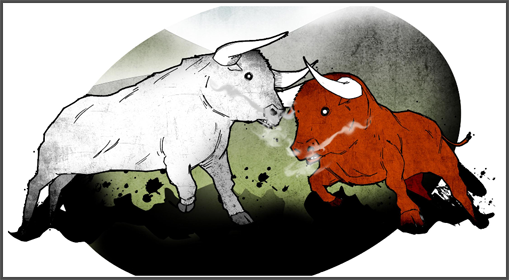
The Sidhe, often referred to as the “Good People” or “Fairy Folk,” are mystical beings deeply woven into the fabric of Irish mythology and folklore. Let us immerse ourselves in the enchanting realm of the Sidhe, where their ethereal presence and captivating tales continue to captivate the hearts and minds of those who venture into the mystical realms of Ireland.
In Irish mythology, the Sidhe are believed to be a supernatural race, dwelling in hidden mounds, ancient forests, and shimmering lakes. They exist in a realm parallel to our own, veiled by a delicate mist that separates the mortal world from their ethereal domain. It is said that these magical beings are descendants of the Tuatha Dé Danann, the divine race of Ireland.
The Sidhe are renowned for their otherworldly beauty and their ability to shape-shift, appearing to mortals as radiant and ageless beings. They possess a deep connection to nature, understanding the intricate rhythms of the land and its creatures. The Sidhe are often associated with shimmering lights, mysterious sounds, and the whispering winds that carry their songs and laughter.
Though their appearance may be enchanting, one must approach the Sidhe with caution, for they possess a mischievous nature and an adherence to their own code of morality. They can bring both blessings and curses upon those who encounter them, depending on their intentions and the respect shown to their realm.
The Sidhe have a rich and complex culture, with their own societal structure and hierarchy. They are led by powerful figures, such as the beautiful Queen Maeve of Connacht or the elusive King Finvarra. These royal figures hold great influence over their subjects and often interact with mortals, bestowing gifts or issuing challenges in exchange for favours or loyalty.
Legends abound of those who have entered the world of the Sidhe, only to emerge days, months, or even years later, despite believing they had only spent a fleeting moment in their ethereal realm. Time flows differently in the realm of the Sidhe, and mortal travellers must be wary of becoming trapped in their captivating domain.
The Sidhe are also known for their love of music, dance, and storytelling. It is said that their melodies can enchant even the coldest of hearts, and their dances can transport mortals to realms of pure joy and ecstasy. Many tales tell of mortals who stumbled upon a Sidhe gathering, drawn into their magical revelries, and losing themselves in the enchantment of the moment.
However, crossing paths with the Sidhe is not without its risks. They can be capricious and easily offended, and mortals must approach them with respect and reverence. To anger a Sidhe is to invite their wrath, which can manifest in various forms, from curses to misfortune befalling those who have incurred their displeasure.
Yet, for those who show humility, kindness, and a deep respect for the natural world, the Sidhe may bestow blessings and gifts beyond imagination. They are known to aid those in need, to offer protection to the vulnerable, and to guide lost souls back to safety.
As we navigate the folklore and mythology of Ireland, the world of the Sidhe beckons, a realm of wonder and mystery. Let us approach their realm with reverence, open our hearts to their enchantment, and embrace the beauty and wisdom they offer. For within the realm of the Sidhe, we can rediscover the magic that lies within ourselves and forge a deeper connection to the natural wonders of the world around us.
As I delve even deeper into the tales, I am reminded of the ancient gods and goddesses who shaped the world around us. From the mighty Dagda, the god of abundance and protector of the land, to the wise and all-knowing Brigid, the goddess of healing and poetry, each deity played a unique role in the tapestry of Irish mythology.
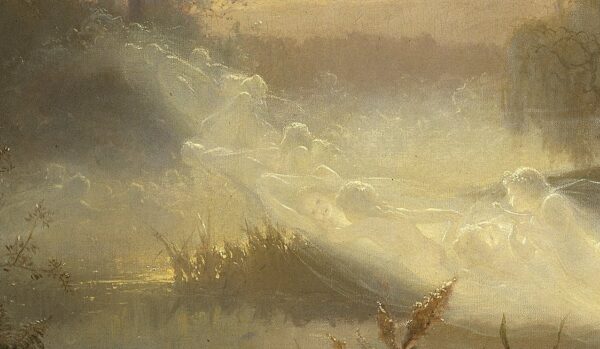
The Dagda, known as the “Good god” or “Father of All,” is one of the most prominent and revered figures in Irish mythology. Let us delve into the tales and legends surrounding this mighty deity, whose power, wisdom, and larger-than-life personality have left an indelible mark on Irish folklore.
The Dagda stands tall as a god of immense strength, unmatched knowledge, and boundless generosity. With his mighty stature and presence, he commands both respect and awe from both mortals and divine beings alike. Often depicted as a wise old man with a large, flowing beard, he is the epitome of paternal wisdom and guidance.
As a god of abundance and fertility, the Dagda holds sway over the cycles of nature and the bountiful gifts of the land. It is said that he possesses a magical cauldron, known as the Cauldron of Plenty, from which no one would leave unsatisfied. With a simple command, he could provide endless sustenance to all who approached him, embodying the concept of nourishment in all its forms.
But the Dagda’s power extends beyond his role as a bestower of abundance. He is a skilled warrior, revered for his prowess in battle. He wields a massive club, known as the Great Oak, capable of felling his foes with a single blow. Yet, despite his strength and martial prowess, the Dagda is known for his compassion and fairness, using his might to protect and guide rather than to dominate.
In addition to his physical strength, the Dagda possesses a vast knowledge of magic and the secret arts. He is a master of Druidic wisdom, possessing the ability to shape-shift, command the elements, and navigate the unseen realms. With his harp, known as the Uaithne, he can evoke powerful emotions, heal the wounded, and even control the very tides of the ocean.
The Dagda’s influence is not limited to the natural world; he also holds sway over the realm of the supernatural. He is considered the chief deity of the Tuatha Dé Danann, the divine race of Ireland, and is held in high regard by gods and mortals alike. His wisdom and guidance are sought by all, and his presence brings a sense of security and reassurance.
But beyond his godly attributes, the Dagda is also a figure of great compassion and humour. He is known for his love of music, feasting, and revelry. His hearty laughter can be heard echoing through the halls of the divine realms, bringing joy and mirth to those in his presence. He is a symbol of merriment and celebration, reminding us to find joy and embrace the pleasures of life.
In the rich tapestry of Irish mythology, the Dagda stands as a beacon of strength, wisdom, and benevolence. His stories serve as a reminder of the profound connection between the divine and the mortal realms, and the enduring power of a fatherly figure guiding and nurturing his children.
So, let us raise our voices in reverence to the mighty Dagda, the good god, whose presence brings abundance, protection, and laughter to all who seek his wisdom. May his lessons and his example inspire us to embrace our own inner strength, to walk with compassion, and to live life with a generous spirit, always mindful of the interconnectedness of all things.

Brigid, the goddess of poetry, healing, and smithcraft, holds a prominent place in Irish mythology and folklore. Let us immerse ourselves in the captivating world of Brigid, a revered figure known for her creative powers, healing abilities, and nurturing nature.
Brigid, also known as “Brigid of the Tuatha Dé Danann,” is a multifaceted deity associated with various aspects of life. She is often depicted as a radiant and beautiful woman, adorned with a crown of flame-red hair, symbolizing her association with fire and inspiration. Her name itself means “Exalted One,” signifying her elevated status and divine presence.
As a goddess of poetry, Brigid is the muse who kindles the creative fire within poets, bards, and storytellers. She bestows the gift of eloquence, filling their hearts and minds with inspiration, and guiding their words to touch the souls of listeners. Through her influence, the art of storytelling and the spoken word are celebrated and cherished.
Beyond her association with poetry, Brigid is also a goddess of healing and nurturing. She possesses the ability to restore and rejuvenate, bringing comfort and solace to those in need. Her gentle touch and compassionate spirit lend themselves to the healing arts, as she tends to the sick, mends broken bodies, and soothes troubled souls.
Brigid’s connection to fire is of particular significance. Fire represents not only the transformative power of creativity but also purification and protection. Brigid’s sacred flame, kept burning in her honour, serves as a beacon of hope, a symbol of warmth and light in the darkest of times. It is believed that her flame has the power to cleanse and bless, warding off negativity and bestowing blessings upon all who approach it with reverence.
In addition to her roles as a muse and healer, Brigid is also associated with the craft of smithing. She is known as the patroness of blacksmiths and craftsmen, guiding their hands, and infusing their creations with her divine spark. The fires of the forge mirror the creative fire within her, and she watches over those who shape and mould metal, imbuing their works with strength and beauty.
Brigid’s influence extends beyond the realms of mythology and into the lives of the Irish people. She is honoured as a saint in the Christian tradition, with St. Brigid’s Day celebrated on February 1st, marking the arrival of spring and the awakening of nature’s dormant energies. This day is marked by rituals, feasts, and the weaving of St. Brigid’s crosses, symbolic of protection and blessings.
As we delve into the enchanting stories of Brigid, we are reminded of the power of creativity, healing, and nurturing in our own lives. She inspires us to embrace our creative talents, to extend kindness and care to others, and to find solace and strength in the transformative power of fire. Let us honour Brigid’s legacy and seek her guidance as we navigate the intricate tapestry of life, fostering our own creative flames and spreading warmth and love to all we encounter.
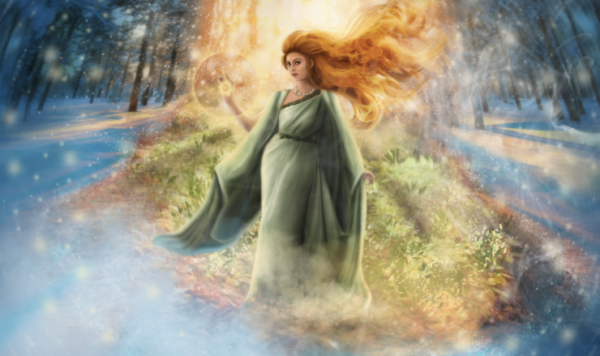
The Morrigan, with her complex and multifaceted nature, embodies both the destructive and regenerative aspects of life. As a goddess associated with sovereignty, she challenges those in power to maintain balance and uphold justice. Her influence extends beyond the realm of war and prophecy, reaching into the depths of the human psyche.
In ancient Ireland, the Morrigan was seen as a harbinger of change and transformation. She would often appear to individuals at critical moments in their lives, pushing them to confront their fears, shed old identities, and embrace their true potential. She was not a figure to be feared but rather an agent of growth and rebirth.
The Morrigan’s presence is often associated with times of upheaval and transition, where old structures and systems crumble to make way for new beginnings. She is a catalyst for personal evolution, challenging individuals to shed their limitations, face their inner demons, and emerge stronger, wiser, and more resilient.
In the realm of battle, the Morrigan is not only a fierce warrior but also a symbol of strategic intelligence. She possesses the wisdom to guide warriors in their campaigns, teaching them the art of warfare, tactics, and resilience in the face of adversity. It is said that those who heed her counsel and embrace her blessings are granted great power and protection.
Yet, the Morrigan’s role extends beyond the physical realm. She is associated with the cauldron of transformation, symbolizing the alchemical process of inner change. Just as metal is forged in the fires of the forge, individuals who invoke the Morrigan’s presence undergo a profound metamorphosis, emerging with a deeper understanding of themselves and their purpose.
Her influence can be felt in the poetic arts as well. The Morrigan is known to inspire bards, invoking their creativity, and guiding their words to convey profound truths. Through the medium of poetry, she weaves stories of love, loss, and the complexities of human emotion. Her influence on the arts is a testament to her ability to touch the depths of the human soul and invoke profound introspection.
As we delve into the mythology of the Morrigan, we are reminded of the cyclical nature of life, the importance of embracing change, and the transformative power of embracing our inner strength. She calls upon us to face our fears, embrace our sovereignty, and navigate the turbulent waters of life with courage and resilience.
The Morrigan’s mythology serves as a reminder that life’s challenges are not meant to break us but rather to shape us into stronger, more compassionate beings. By aligning ourselves with the energy of the Morrigan, we can tap into our own inner power, discover our true potential, and emerge victorious from the battles we face, both external and internal.
Let us embrace the lessons of the Morrigan, harnessing her wisdom and strength to navigate the ever-changing tides of life. May we find solace in her guidance, drawing upon her transformative energy to face our fears, embrace our sovereignty, and embark on our own heroic journeys of self-discovery and personal growth.
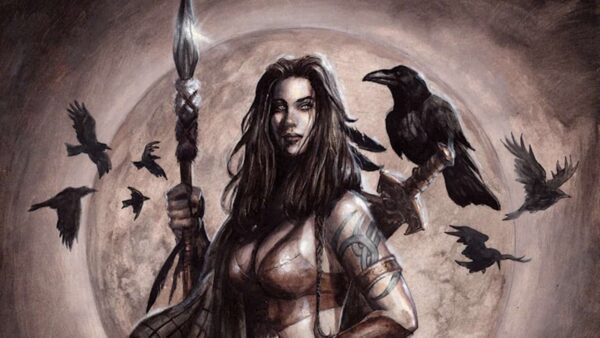
As our journey through the captivating realms of Irish mythology comes to a close, we are left with a profound appreciation for the richness and depth of these ancient tales. From the enchanting Tuatha Dé Danann to the mighty figures like Cú Chulainn and the Morrigan, the stories of Ireland have shaped our understanding of the human experience, offering wisdom, inspiration, and a connection to our ancestral roots.
Through the mythological tapestry of Ireland, we have explored themes of bravery, love, honour, and the eternal struggle between light and darkness. We have witnessed the triumphs and tragedies of heroes, the complex nature of gods and goddesses, and the enduring power of folklore in capturing the essence of the human condition.
But the tales do not end here. They continue to be told, passed down through generations, and reimagined in countless forms. They live on in the hearts and minds of those who seek solace and inspiration in the stories of old, reminding us of the timeless truths that transcend time and place.
As we bid farewell to these mythical realms, let us carry with us the lessons learned from the Tuatha Dé Danann, the strength and courage of Cú Chulainn, the wisdom and mystery of the Morrigan, and the enduring spirit of the Irish people. May we continue to honour and celebrate the myths and legends that have shaped our collective consciousness, and may we find solace and inspiration in their timeless wisdom.
So, let us raise a toast to the heroes and heroines of Irish mythology, to the gods and goddesses who have captured our imaginations, and to the storytellers who keep these ancient traditions alive. May the tales of Ireland continue to ignite our hearts, guide our paths, and connect us to the rich tapestry of human experience.
As we step back into the realm of the everyday, let us carry the spirit of these stories within us, allowing their magic to illuminate our lives and inspire us to embrace our own heroic journeys. For in the realm of myth and folklore, we discover not only the beauty and wonder of ancient Ireland but also the timeless truths that resonate with the very core of our being.
And so, with gratitude in our hearts and a sense of wonder in our souls, we bid farewell to the realms of Irish mythology, knowing that their legacy will forever live on, inspiring generations to come. May the stories continue to weave their enchantment, reminding us of our connection to the past and our limitless potential for the future.
Slán abhaile, dear friends, until we meet again on the magical shores of Irish mythology. May your own journeys be filled with adventure, wisdom, and the enduring power of storytelling.

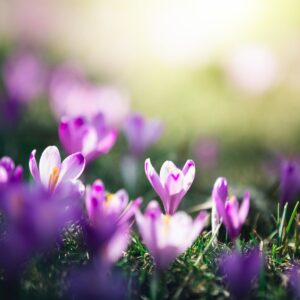
Easter Morning on Sacred Soil
The dawn breaks soft o’er Brigid’s well,Where primrose bloom and thrushes dwell.The hawthorn stirs, its blossoms shy,And whispers stir the

Embracing Life’s Lessons
Dear fellow seekers of wisdom, sitting with my guides we talked about having failures. My dear friend, it
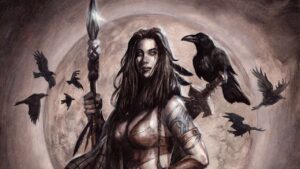
A Journey Through Irish Legends
Irish mythology, captivating tales, ancient folklore Once upon a time, in the lush green landscapes of Ireland, where the mists
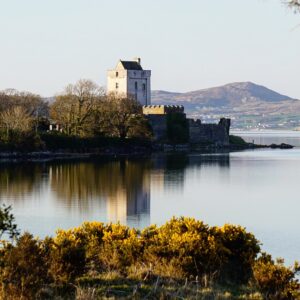
The Haunting of Doe Castle
Castle in County Donegal One day Caroline’s mother had decided to take Caroline and Aishling on a special outing to
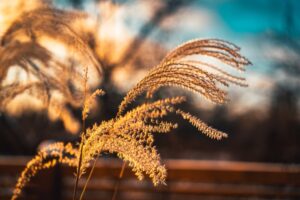
A Summer Day in the Irish Countryside
Hay Farming It was a hot summer day in Ireland, and Caroline and Aishling had been asked to help Caroline’s
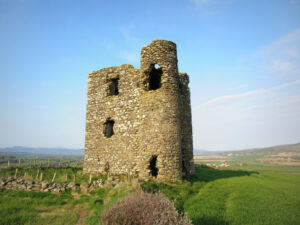
Caroline’s Adventures with the Scouts in Donegal.
Tea is the elixir of the storyteller’s soul, fueling the imagination and soothing the mind. So grab a cup,
